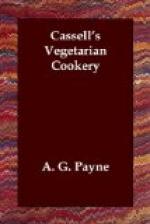and the skins should be boiled with the fruit.
Apple jam is made of the fruit after the juice has
been drawn off for jelly. Economical housekeepers
will find that very excellent jelly can be made of
apple parings, so that where apples in any quantity
have been used for pies and tarts the skins can be
stewed in sufficient water to cover them, and when
the liquor is strongly flavoured it can be strained
and boiled with sugar to a jelly. To make apple
jelly, pare, core and slice the apples and put them
into a preserving-pan with enough water to cover them.
Stir them occasionally and stew gently till the apples
have fallen, then turn all into a jelly-bag and strain
away the juice, but do not squeeze or press the pulp.
Measure the liquid and allow a pound of sugar to a
pint of juice. Put both juice and sugar back into
the preserving-pan, and, if liked, add one or two
cloves tied in muslin, or two or three inches of lemon-rind.
Boil gently and skim carefully for about half an hour,
or till a little of the jelly put upon a plate will
set. Pour it while hot into jars, and when cold
and stiff cover down in the usual way. If yellow
jelly is wanted a pinch of saffron tied in muslin
should be boiled with the juice. To make apple
jam, weigh the apple pulp after the juice has been
drawn from it, rub it through a hair sieve, and allow
one pound of sugar to one pint of pulp, and the grated
rind of a lemon to three pints of pulp. Boil
all gently together till the jam will set when a little
is put on a plate. Apple jam is sometimes flavoured
with vanilla instead of lemon.”
DAMSON JELLY.—Damson jelly can be made
in two ways. The juice can be boiled with sugar
till it gets like red currant jelly, or the juice of
the damsons can be sweetened with less sugar and thickened
with corn-flour. In order to extract the juice
from damsons they should be sliced and placed in a
jar or basin and put in the oven. They are best
left in the oven all night. If the mould of jelly
is made in a round basin, a single whole damson can
be placed on the top of the mould and green leaves
placed round the base.
PINE-APPLE JELLY.—The syrup from a preserved
pine, should the pine-apple itself be used for mixing
with other fruits, or for ornamental purposes, can
be utilised by being made into a mould of jelly and
by being thickened with corn-flour. It will bear
the addition of a little water.
APRICOT JELLY.—The juice from tinned apricots
can be treated like that of pine-apple. When
a mixture of fruits is served in a large bowl, the
syrup from tinned fruits should not be added, but
at the same time, of course, should be used in some
other way.
MULBERRY JELLY.—Mullberries, of course,
would not be bought for the purpose, but those who
possess a mulberry tree in their garden will do well
to utilise what are called windfalls by making mulberry
jelly. The juice can be extracted by placing
the fruit in a jar and putting it in the oven; sugar
must be added, and the juice thickened with corn-flour.
There are few other ways of using unripe mulberries.




